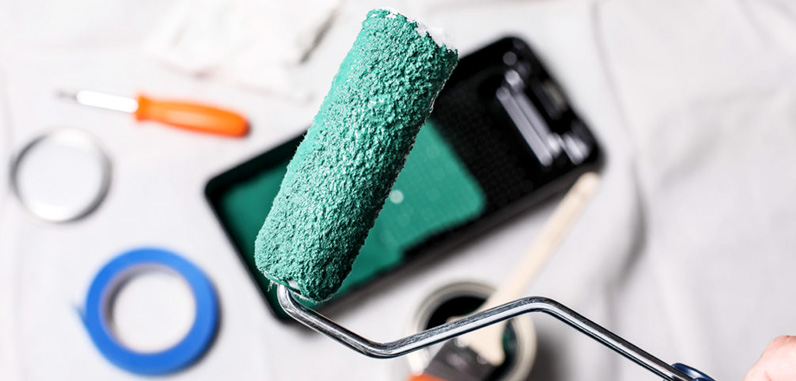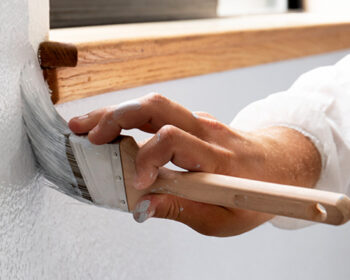
Rolling vs Spraying Paint: Which One Fits You?
Are you preparing to paint your house? One of the first thoughts that may come to mind when preparing to paint, whether indoors or outside, is: Which is preferable, spraying paint or rolling paint?
When comparing rolling paint versus spraying paint, there are numerous distinct benefits and drawbacks. In general, rolling paint is the most approachable for beginners. While applying spray paint requires extensive preparation, the process is quicker. To stop overspray, a lot of heavy taping and masking are needed. Additionally, a sprayer applies paint more consistently than a roller.
For painting interior walls, a roller works well. Both interior and external walls can be painted with a sprayer. Additionally, a sprayer can be used to paint brick, concrete, and other tough surfaces. The paint wouldn’t be applied evenly using a roller. Trying to roll on those surfaces would be too difficult.
In this article our Melbourne based house painter will explain pros and cons of spraying and rolling.
Spraying Paint Pros
Coating is evenly applied
Your wall will receive a consistent coating from a sprayer. The type of nozzle you use has a significant impact on the sprayer’s coverage. Sprayers typically come with a variety of nozzles that you can try out.
The paint applies thinner the more coverage the sprayer provides. Therefore, you might want more coats than usual if you are using a nozzle that sprays quite far from the centre.
Painting takes far less time than rolling
“Time to paint” is the key distinction in this sentence. We’ll talk about prep later because it’s a separate situation. But once everything has been prepared for painting, spraying is significantly faster than rolling.
Reaches the wall’s difficult-to-reach grooves
A sprayer works well to access places that a roller cannot. Corners, groves, and fissures can all be painted quite uniformly. You would need several different-sized rollers to do the same thing with a roller. While not terrible, this requires an additional step.
Excellent for use outside or on tough surfaces like brick and concrete
A sprayer has a wide range of uses. Even some of the roughest or most porous surfaces can be painted. The best feature is how evenly it applies. When spraying brick, concrete, or other exterior surfaces, the number of coats is the most important factor to take into account.
How fast does the surface take paint? The surface may require multiple applications if paint absorbs quickly.
Before painting, it can occasionally be good to softly mist the surface with water and let it absorb. For your project, you would spend a lot of money on paint because some materials are so porous. Adding some water to the material can lower that expense.
Spraying Paint Cons
Requires extensive preparation to avoid overspray
The prep work is typically mentioned as the primary drawback of spray painting. It takes a lot of labour to prepare the sprayer for usage, learn how to use it, mask, tape, and lay down paper to protect your floors.
So why all the preparation? Overspray is the primary culprit. Overspray is the term for spraying onto baseboards, windows, and other areas that were not intended. Cleaning up after this can be a huge hassle. So be sure to prepare in order to work more effectively.
Sprayers may be costly
The majority of paint sprayers cost between $100 and $300. Professional sprayers are also available for more than $300. These are more suited to painters and other contractors than to the majority of homeowners.
Not suitable for beginners
Most inexperienced painters should avoid using a sprayer. Even just figuring out how to operate the device might be a chore. You might unintentionally push a button. may make a mistake and paint something you didn’t intend to. Alternatives like rollers are more easier and provide more room for error.
Rolling Paint Pros
Easy to use , excellent for new DIYers
The most basic way to paint is by rolling. All you require is a tray, paint, and a roller. Of course, you’ll need to tape and mask some areas at first. However, painting is as straightforward as it gets.
Make sure the roller isn’t overloaded. Many drips will need to be caught quickly before they touch the ground. If you’ve never painted before, go light on the paint with your roller.
Affordable
The most expensive cost will be the required paint. The actual equipment is quite affordable. You can need a couple various sizes of rollers, depending on your project. Of course, you’ll need different trays for the various paint colours. But the trays are not expensive.
Doesn’t need a lot of equipment
Rolling paint effectively doesn’t call for a lot of equipment. a tray, some paint, and a roller. The most crucial step if you’re a beginner painter is to properly mask and tape. In the event that you make a few blunders when painting, this will provide you more freedom.
Simple to tidy up
Warm water and some dish soap can be used to clean the roller. To avoid drying, just make sure to clean the roller right away. Simply get a new roller if you unintentionally leave one outside with paint on it. Don’t even bother attempting to fix it. Your budget won’t suffer significantly if you buy one or two new rollers. Brushes can also be cleaned with warm water and soap.
Can use a roller extension for hard-to-reach areas
A roller can still be a useful choice, despite not reaching confined spaces as well as a sprayer. Invest in a roller extension if your ceilings are high, or just buy a long roller that works for you. It will get to places where a sprayer can’t.
Remember that your roller will be more difficult to manoeuvre the farther it is off the ground. Consequently, use extreme caution when painting those high locations!
Rolling Paint Cons
For interior use only
Rolling is typically done inside. Exceptions might apply if you’re painting a wall in a covered outdoor space. But usually those surfaces are made of rough materials like brick or concrete. For those surfaces, spraying works best.
You might have to catch a lot of drips
You might notice a lot of drips while you paint, especially if you’re a beginner. To get a smooth coat, it’s crucial to catch those, but it can be challenging. Think about bringing a friend to keep an eye on you while you paint. To help you with your work, have them catch the drips as you roll.
It may not be as evenly applied as a sprayer
The majority of the time, rolling paint doesn’t apply as evenly as a sprayer. You’ll get a different amount of paint on your roller each time you dip it into the paint tray. You might also roll over a wall twice and then four times in two different places. Making the coat as even as possible is therefore the key issue.
Painters with experience will be able to use a sprayer to apply paint uniformly. But if you’re just starting out, be careful.





